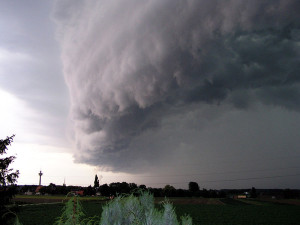We rarely see natural disasters in the state of Pennsylvania, so when they hit it often sends people into a state of panic. Like troops, we assemble at the grocery store at the sheer mention of snow. During flooding we evacuate after moving our most valued positions to the second floor. The outcome is never certain, but one thing that is certain; in a state of panic our pets can be forgotten. How do we keep our pets safe and prepared during these stressful times? It is best to be prepared for these various situations, and it is a lot easier than most people may think.

Storm image referenced from wikipedia and originally posted by Gewitter
What to do First
Start by getting your pet microchipped. Microchipping is one of the easiest ways to identify your pet in case it should be separated from you. Collars with ID tags are great, but pets can get out of a collar. Microchipping can be done at veterinary offices, pet supply stores (when a clinic is held), and some local shelters. In the event that you have your pet microchipped, make sure that the information is current! If you move, change your name, change your phone number, or change ownership update the microchip. Some people may do this service at no charge or a small fee, but you can easily do it online at no cost to you. Most microchips do not cost very much ($15-$20), so it is a small price to pay in order to protect your pet. Learn more about the importance of microchipping here.
Be sure to keep vaccines current too. Pets may roam for a while before they are discovered by a passerby, or show up in a public location. During this time, your pet is at the mercy of the wilderness. Your pet could be exposed to wildlife, various food and water sources, and a wide range of viruses. Stress also creates a weakened immune system. While having your pets up to date on vaccinations is not a guarantee of their safety, it is extremely beneficial to their survival.
 Build a Pet Emergency Kit
Build a Pet Emergency Kit
Emergencies can happen at any given time, so it’s best to be also prepared for these given situations. Come up with an evacuation plan, and have drills with your family and pets. In case of injury, or loss of shelter, purchase a ready-made first aid kit or make one on your own. Be sure to place the kit in an accessible area. If you would like to make your own kit, here is a list of materials that you will need.
Emergency Contacts List
• Pet’s regular vet contact info and address
• Emergency vet contact information, in case your vet is not available or close by
• Poison Control Phone Number
Supplies
• Clean towels (both cloth and paper)
• Cotton balls and swabs
• Disposable Gloves
• Heat pack or hot water bottle
• Lubricant jelly (mineral oil, KY)
• Nail Clippers
• Kwik-Stop powder or gel
• Hemostats
• Small penlight or flashlight
• Rectal Thermometer
• Scissors
• Syringes of different sizes
• Tweezers
• Wire Cutters
• Bandage Wrap
• Gauze of different sizes
• Band-Aids
• First Aid Tape
• Non-stick pads
• Unflavored Pedialyte
• Saline Solution
• Triple antibiotic ointment for skin
• Probiotic gel (BeneBac, LactoBac, Probios, or Fastrack)
• Wound Disinfectant (Betadine, Povidone)
• A plastic bag of their food
• Blanket
• Favorite toy
• Crate/carrier
• Spare leash and collar
• Any current medications
Some of these items may expire over time, so be sure to check your first aid kit often so that items can be replaced or replenished. While this kit serves as an emergency kit, it can also be used while traveling. Be sure to get your pet proper medical attention as soon as you are able to. Remember that our pets will feed off of our energy. If we are calm, our pet will be calm. In the event that your pet appears to be anxious, be sure to give them their space. Scolding your pet at this time will not benefit either party.
No one wants to be involved in a disaster of any kind, but they do happen. It is best to be prepared, remain calm, and ensure the safety of yourself and all of your loved ones.
 That Pet Blog That Pet Place Pet Blog
That Pet Blog That Pet Place Pet Blog
